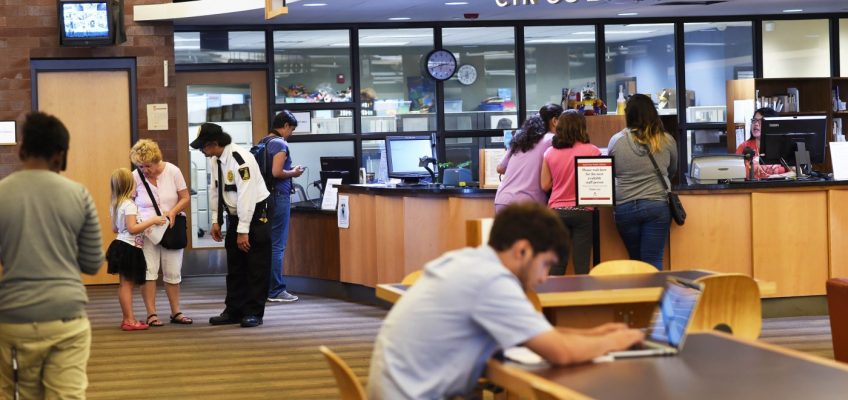St. Paul Mayor Melvin Carter’s no fun, no frills budget proposal calls for city department leaders to freeze most hiring and keep vacant positions unfilled. It’s a stiff request for the St. Paul Public Library system, which plans to cut four hours weekly from the Arlington Hills Public Library as a direct result.
The library budget proposal also funds security improvements to the Rondo Community Library, which would close during construction, and the remodel of the Hayden Heights Library.
Twice a week come January, the Arlington Hills Public Library would open at noon instead of 10 a.m., a direct response to losing the hourly equivalent of 1.3 librarians and custodians to vacancies and retirements. That adds up to about a $129,000 cut to the library system’s staffing budget.
The budget for substitute staffing also would be reduced $44,000, or 18%, equivalent to losing 34 hours of fill-in staffing per week throughout the library system, and a position in library operations will be repurposed from executive assistant to office assistant.
“I don’t want to reduce public services hours anywhere,” said Maureen Hartman, director of the St. Paul Public Library, addressing the St. Paul City Council on Wednesday as they convened as the city’s library board. “Nothing that I’m putting here on this list makes us happy, and yet these are some choices that we’re putting forward.”
Tough decisions
Forced to make tough decisions, Hartman said she queried staff and looked at circulation times and foot traffic to decide where to reduce hours, and found that Arlington Hills was busiest in the afternoons and evenings, or on select mornings when there’s a children’s story time.
That came as little consolation to council member Nelsie Yang, who said the city needs to prioritize keeping recreation centers and libraries open despite budget challenges.
“I am very opposed to the hour reductions here,” Yang said. “Not everybody who comes into the library comes and checks out books.”
“They’re there for a play space, as well. It serves many other purposes,” Yang added. “This is an area of the East Side where there are very high needs. It’s very, very shocking to see this be part of the proposal, and I’m very opposed to it.”
Rondo to shutter for security improvements
That’s not the only change in store for the library system, which will temporarily shutter the Rondo Community Library at Dale Street and University Avenue to make security improvements following a number of incidents that have put staff in conflict with unruly guests or young patrons.
The $793,000 project, to be funded by state public safety aid, will reconfigure the library’s entryway, relocate restrooms deeper into the building and move the service desk closer to the entrance.
A timeline has yet to be finalized, but during construction, which could get underway before the end of the year, books and services will be relocated to the Hallie Q. Brown Community Center on North Kent Street through a $100,000 lease.
“We’ve let our staff know that we may not need all of our staff at Hallie Q. Brown,” Hartman said. “All of our staff will remain employed. What that may mean is they may be temporarily working out of another library.”
Budget proposal
Carter’s overall city budget proposal, which was released last week, calls for a 5.3% increase to the city’s property tax levy. Yang said Wednesday that she wants to see that number drop further, though other members of the city council have said they appreciate that the proposed increase wasn’t larger.
The mayor opened budget season a year ago calling for a 7.9% increase, which the council reduced to 5.9% last December through an acrimonious process involving last-minute vetoes.
The library would operate next year on a $23.14 million budget, an approximate increase of $636,000, or 2.3%. That’s in addition to $4.26 million in special funding, which includes the state aid for work on the Rondo Library, among other projects.
For library materials, or the collections budget, the mayor’s proposed 2026 library budget includes $967,000 in general fund support, a reduction of $65,000 compared to 2025. That would be partially offset by up to about $40,000 in funding from the Friends of the St. Paul Public Library, which also is reflected in the special fund budget.
Funding to maintain the “Read Brave” student literacy program also would come from the special fund, backed by another one-time $20,000 donation from the Friends of the St. Paul Public Library. It’s unclear how the program will be funded after 2026, Hartman said.
Public safety incidents down
The library system drew 1.7 million visitors last year, a 10% increase over 2023. Numbers this year are trending a bit less as a result of a lengthy cybersecurity incident interrupting access to public-facing computers and other services, according to library officials. Including both its website and mobile app, the library system also drew 4.5 million online visitors last year, a 20% increase from 2023.
Hartman said reported public safety incidents throughout the library system are on track for a 40% reduction this year compared to 2024, in part due to monthly or bi-monthly staff training that is also becoming a standard part of onboarding new employees.
Six library “safety specialists” and a safety manager have been installed at hotspots, including the George Latimer Central Library and the Rondo, Rice Street and Sun Ray libraries.
Throughout 2026, the library system also plans to fully roll out a restorative practices initiative aimed at determining when and how to allow a patron who has violated codes of conduct back into a library building. Some staff have objected to managers calling the St. Paul police on youth misbehaving at the Rondo Library and other locations, even when some patrons call it necessary.
“Always the tension in our safety work is what is the line between (barring someone for unacceptable behavior) and ‘you’ve made a mistake, but we want to restore your library access,’” Hartman said.
Hartman said she planned to present more on the library safety strategy to the city council’s public safety committee in September.
Major construction and enhancements
Meanwhile, major renovations or rebuilds of three libraries are on the horizon.
Construction of a new, $10.4 million Hamline-Midway Library on Minnehaha Avenue has been underway for months, with an opening expected by the end of 2026. With about $3.5 million in funding falling into place from the city’s Capital Improvement Budget, the remodel of the Hayden Heights Library will begin next year.
Related Articles
St. Paul City Council cuts vacant building fee for Donut Trap business
Pedro Park dedicated after 28-year battle for scarce downtown green space
Mayor wants 5.3 percent increase to St. Paul tax levy
Molly Coleman is seated on the St. Paul City Council
Letters: A lack of trust when it comes to the Summit Avenue bike trail
The Capital Improvement Budget proposes $784,000 to be put toward the $11.2 million renovation of the Riverview Library in 2027, on top of funds already in hand, but that still leaves about a $9 million budget gap before construction can begin. Work could, in theory, run from 2027 or 2028 into 2029.
The library system has selected a vendor for the creation of design standards for new “Play and Learn” interactive learning services in all locations, with enhancements coming to the Sun Ray Library next year.
With its remaining American Rescue Plan Act dollars, the library system plans to complete a $1.25 million RFID-related modernization project by the end of 2026. Technology enhancements to the Merriam Park and Rice Street libraries will be completed later this year.




